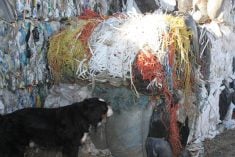If Rigas Karamanos is remembered for only one thing, it would probably be his strict adherence to a stringent scientific approach to research. This dedication is reflected in his famous quote:
“In God we trust. All others bring replicated data.”
The soil scientist is also known for a lot of other contributions to fertility management on the Prairies.
His two cent experiment typifies his unique approach to weeding out bad data from valid data and then communicating the truly significant information to farmers.
In replicated trials across all three provinces, Karamanos tossed two pennies into one set of plots and left the control plots penny-less. When it came time to crunch the data, the plots with the two cent treatment had a slight yield advantage over the no-penny plots five percent of the time.
Read Also

Message to provincial agriculture ministers: focus on international trade
International trade stakeholders said securing markets in the face of increasing protectionism should be the key priority for Canada’s agriculture ministers.
He has used this data over the years to show how careful a producer, researcher or marketing person must be when dealing with data. The two pennies had nothing to do with the yield bumps. Instead, such fluctuations are typical in all data collection and are attributed to normal irregularities always found in research.
He has always cautioned against “cherry picking,” or making choices based on data highs and lows, especially when dealing with fertilizer rates or alternative plant nutrition products.
Karamanos has never shied away from controversial topics. Instead, says Don Flaten, a soil scientist at the University of Manitoba, he dives into sensitive areas with unwavering objective research.
Flaten said Karamanos has presented his research findings at 710 extension meetings and has published 374 research reports in scientific journals since 1982.
“Rigas has taken on some very difficult issues relating to alternative forms of phosphate fertilizer and biological inoculants,” he said.
Research supporting these types of products often had mixed results, Flaten added.
“Rigas wants to make sure that whatever is marketed, be it a product or a practice, has been well-challenged in a rigorous scientific manner.”
That stand sometimes puts Karamanos at odds with the marketers, but Flaten said he wants to make sure that the only products that are promoted are those that are ultimately good for the farmer.
“It’s kind of a tough issue to deal with as an agronomist working for a crop supplies retailer, but Rigas always provides a scientifically sound and informed opinion,” he said.
John Heard, a fertility specialist with Manitoba Agriculture, remembers when Manitoba farmers had become increasingly suspicious of fertilizer guidelines, which had not been updated since 1992 when the provincial soil lab was sold. The old guidelines were based on fields with deep tillage and black summerfallow.
Karamanos, agronomy manager for Viterra, volunteered the massive nitrogen database he had collected while he was agronomy manager for Westco.
“It seemed like an impossible task to make sense out of 250 nitrogen soil studies,” Heard said.
“We tried a few things and talked to some people who we thought could handle the project, but there was no progress. It seemed impossible. We nearly gave up.
“Then in 2008, Rigas said he’d like to give it a try. Amazingly, he crunched the numbers and came back to us with a nitrogen calculator that was relevant to our current farming practices.”
The interactive program developed by Karamanos gives a producer the option of changing fertilizer sources, costs, commodity prices and nitrogen rates. In an instant, the calculator gives the user the economic consequences of each decision.
Karamanos has since expanded his Manitoba nitrogen calculator to include Saskatchewan and Alberta. There are two calculators for the brown soil zone, one for stubble and one for fallow. The dark brown and parkland soil zones each have their own nitrogen calculators.
Once the nitrogen work was completed to his satisfaction, he turned his attention to a phosphorus calculator, which he released last year.
“The phosphorus calculator is universal,” Karamanos said. “It doesn’t relate to soil zones. Last year I turned it over to the Canola Council (of Canada) for their website.… These things are of no value being stuck someplace. It took me years and years to finally convince Viterra to put the nitrogen calculator up on the website.”
His recent work in anhydrous ammonia retention typifies his producer-oriented approach to research rather than a purely academic approach.
Karamanos wanted to see if anhydrous ammonia was more likely to be lost if applied at certain points on the calendar. His conclusion is that it doesn’t matter when anhydrous is applied in well drained soil.
“We applied anhydrous Sept. 19-21. Then we applied anhydrous Oct. 19-21. And finally we applied it in the spring,” he said.
“After four years of data, we got the same yield regardless of when the anhydrous was applied. That gives farmers a much bigger window for their anhydrous ammonia applications.”
“Rigas was the first researcher to take micronutrients seriously. Until then, micronutrients were viewed by both farmers and scientists as elements of a mysterious pixie dust,” Heard said.
“When he began studying micronutrients in 1985, he completely removed the mystery for all of us. I think today most farmers have a good knowledge of how micronutrients impact their crops.”
Karamanos never shied away from too much data, according to Cindy Grant, a soil researcher at Agriculture Canada’s research centre in Brandon. She said farmers often ask why people like her and Karamanos need so much data before making a recommendation.
“It’s because there is so much variability in a field or even in a plot. There’s explainable variability and non-explainable variability,” she said.
“But you can’t throw out the non-explainable variability. That data may hold the answer you’re looking for. That’s what Rigas does best. He tries to understand which numbers are real and which are not real.
“And that’s why researchers like us are so anal about having six years of data from four replications at a dozen sites. That’s all necessary to give farmers good information.”
She said Karamanos has always been at the forefront of explaining to agronomists and producers that if they don’t have a large database upon which to make recommendations, then they have nothing.
“If you’ve never conducted research, you don’t know the wide variations you get in results. It’s normal to get extremes,” he said.
“Those extremes lead to cherry picking. People selling a particular product have a tendency to focus on the numbers that support their point of view. Extremes at the opposite end are tossed out as unexplainable variables.”
Grant said Karamanos has always challenged the fallacy of cherry picking data. His two penny study is a good example of how data can be manipulated, she added.
“It’s especially true when you’re dealing with trace elements or some of the miracle products where responses tend to be smaller and more varied. In those situations, if you throw out the numbers you don’t understand, then you truly are manipulating the data.
“People don’t realize that sometimes a non-response is really the valid number you need for an honest result. A non-response can mean the crop already has enough of whatever it is you’re applying.”















